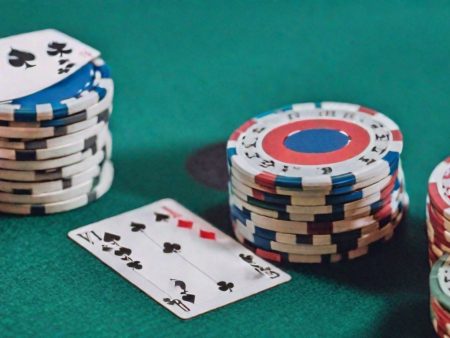Before diving into the exciting battles at the poker table, every participant must contribute — the buy-in. This step, which refers to the monetary contribution made to enter the game, opens the doors to the thrilling world of poker, where intense action and high stakes unfold. The buy-in is not just a term; it’s a crucial part of the game, a word borrowed from the English “buy-in,” meaning “entry” into the game.
What is a Buy-In?
Simply put, a buy-in is the amount of money a player needs to pay to participate in a game. It’s like buying a ticket to enter a club, allowing you to exchange money for chips and take a seat at the table. The buy-in is a mandatory fee in real-money online poker, marking the starting point for every player. Whether it’s a tournament or a cash game, the buy-in is the invisible link connecting all players.
However, the buy-in is more than just a payment for entry. It’s also a kind of initiation into the world of poker, a ritual that makes every game more meaningful. The amount of the buy-in can vary depending on the event organizers, who set the game’s terms. In the poker room lobby, you can always find information on how much you need to pay, what bonuses are available, and how to fund your account.
For beginners, there are also options like freerolls, which allow players to enter tournaments for free, earning money or bonuses along the way. Despite this, the buy-in remains a fundamental part of the game, distinct from a bankroll — the total amount of money a player is willing to risk at the table.
Read also: What is Broadway in poker?
The Buy-In in Cash Games
Blinds in poker are not just bets but also a strategic element of the game. They not only set the starting bet size but also help determine how much a player must contribute to begin. The higher the blinds, the larger the buy-in. This amount shows how much a player needs to pay to start the game and what opportunities are available at the table. In most cases, once the buy-in is paid, the player is exempt from additional poker room fees.
The conversion of real money into poker chips is usually straightforward and easy to understand, and the system helps players feel confident. Tournament organizers, on the other hand, receive a rake — a commission charged on every hand dealt. It’s also important to note that in poker, money is not only used for buy-ins but can also be withdrawn. For example, if a player buys 10,000 chips, loses 2,000, and decides to leave the game, 8,000 real money will be returned to their account.
Tournament Buy-In: How Does It Work?
In a tournament, the buy-in plays a special role. It’s a mandatory fee that significantly impacts the total prize pool. The buy-in consists of two parts:
- The fixed amount — goes directly into the prize pool.
- The poker room’s commission — no more than 10% of the buy-in amount.
For example, if the buy-in is $50, the player will pay $55, and out of those $55, $50 will go into the prize pool, while $5 will be kept by the poker room. Unlike a cash game, where players can get their money back, in a tournament, the opportunity to retrieve funds arises only if the player wins.
How Buy-In Affects Cash Games
In poker, every decision matters, and the choice of stack size is no exception. In cash games, the stack size has a significant impact on a player’s strategy. Players can choose to play with a small or large stack, and this decision heavily influences their chances of winning. For beginners, the right buy-in and stack size can be the key to success or failure.
Professional players typically go for large stacks in high-limit games, where the stakes are higher, and the strategy is more complex. New players, on the other hand, are advised to start with smaller stacks to gradually get a feel for the game.
Types of Stacks: Which One to Choose?
- Short Stack — up to 40 big blinds. Ideal for players who are willing to take risks, often make all-in bets, and follow an aggressive strategy.
- Medium Stack — up to 80 big blinds. The perfect choice for late-stage play, requiring good skills and strategy.
- Deep Stack — 100 big blinds or more. Best suited for experienced players who can play a wider range of hands and employ various strategies.
Professional players often go for high-limit games with larger stacks, while beginners may start with lower stakes and gradually adjust their approach.
Automatic Buy-In: Convenient and Simple
Some poker rooms offer an automatic buy-in feature through Auto Buy-In. This allows players to automatically replenish their stack between hands, making the game more convenient and efficient. If there aren’t enough funds for the next buy-in, the system will offer to top up the account, allowing the player to continue participating.
Read also: What is an overpair in poker.
Rebuy: An Additional Opportunity
In some tournaments, there’s an option to rebuy — a second buy-in if a player loses all their chips. This allows the player to stay in the game and continue competing. The number of available rebuys depends on the tournament rules, adding an interesting dynamic and strategic opportunities for players.
Frequently Asked Questions
For players participating in high-stakes cash games, choosing the right bankroll is crucial. This requires considering various factors such as blind structure, game strategy, and tournament details. Some might wonder how to cover the buy-in if their budget is limited. In such cases, bonuses and tickets can serve as an alternative to cash contributions. This highlights the importance of participating in poker room promotions and utilizing different funding options. In tournaments with a double buy-in, players make two payments — the main and the additional one. The additional sum goes to the prize pool and may affect player strategies. Not sure how to choose a slot or understand RTP? Read the slot and casino guide and get all the insights you need!
FAQ: What is buy-in in poker– definition of the term
What is a buy-in in poker?
A buy-in is the amount of money a player needs to pay to join a poker game or tournament.
It typically determines the chips a player receives to participate in the game.
How does the buy-in work in cash games?
In cash games, the buy-in is exchanged for poker chips of equivalent monetary value.
Players can leave the game at any time and cash out their chips for the remaining amount.
What is the buy-in structure in poker tournaments?
In tournaments, the buy-in provides players with a set number of chips that do not have a direct monetary value.
Once a player loses all their chips, they are eliminated, and the game continues until one winner remains.
What are rebuys and add-ons in tournaments?
A rebuy allows players to purchase additional chips if they lose their initial stack during the early stages of a tournament.
An add-on is an optional purchase of additional chips, usually available during a break or at a specific point in the tournament.
What is the difference between a minimum and maximum buy-in?
The minimum buy-in is the least amount of money required to enter a game, while the maximum buy-in sets a limit on the amount a player can bring to the table.
This range ensures a fair playing field and consistent stakes among participants.
Why are buy-ins important in poker?
Buy-ins create a uniform starting point for all players, ensuring fair competition.
In tournaments, they also contribute to the prize pool, determining the payouts for top finishers.
What are typical buy-in ranges in poker games?
Buy-ins vary widely based on the type of game and stakes:
- Low-stakes games may have buy-ins as small as $1–$20.
- Mid-stakes games range from $50–$500.
- High-stakes games and professional tournaments can have buy-ins of thousands or even millions of dollars.
How should players decide on the right buy-in level?
Players should choose a buy-in level that matches their bankroll and comfort level.
A common guideline is to have at least 20–30 buy-ins for the stakes being played to manage variance effectively.
Can buy-ins influence table dynamics?
Yes, buy-ins can affect table dynamics.
Players who buy in for the maximum often have more flexibility in strategy, while those with smaller buy-ins may play conservatively to avoid losing their stack quickly.
What is a freeroll, and how is it different from standard buy-ins?
A freeroll is a poker tournament with no entry fee (buy-in), allowing players to compete for prizes without risking their own money.
Freerolls are popular among new players and those looking to build a bankroll without investment.
Are there any fees associated with buy-ins?
Yes, most poker games and tournaments include a rake or entry fee as part of the buy-in.
For example, in a $10 + $1 tournament, $10 goes to the prize pool, and $1 is retained by the organizer as a fee.
What is the role of buy-ins in bankroll management?
Buy-ins are a critical part of bankroll management, helping players determine the stakes they can afford to play.
Proper management ensures players can withstand variance and avoid going broke.
How do buy-ins differ in online and live poker?
The concept is the same, but online games often feature lower minimum buy-ins, making them more accessible to casual players.
Live poker buy-ins may include additional costs, such as travel or venue fees.






